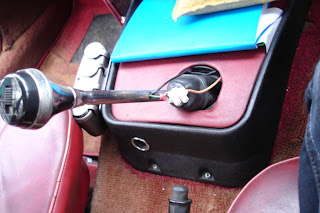The old water pump had not leaked that_much, but it was certainly on its way out, with a notable increase in end float of the pump and quite noisy bearing. Certainly much better now with the new pump.
Over the weekend, I sent through the stores shed and picked through my collection of Lucas distributors to decide which one to fit. I decided to go for a Lucas 45D6 distributor, as while it doesn't have a vernier adjuster for the vacuum advance, I do happen to have a supply of good rotor arms from Rarebits, as they are the same as those used on the 2000 saloon.
As the chosen distributor had been sat in a box for some months, it was stripped down, cleaned up and lubricated as necessary before re-assembly and while I was in there, the wire from the coil to the points was re-soldered for good measure and the points cleaned up.
 Although I should have done it some time ago, before starting the engine, the end float of the distributor drive has been set. This is done using thin shims between the distributor pedestal and the block, at only 4thou each they hardly seem thick enough to do anything.
Although I should have done it some time ago, before starting the engine, the end float of the distributor drive has been set. This is done using thin shims between the distributor pedestal and the block, at only 4thou each they hardly seem thick enough to do anything.A tax disc was also brought earlier on in the week; I've had to pay for it this time, as although the car was first registered before 1973, the taxation class of it has not been changed to historic vehicle yet. It seems that to change the taxation class of a vehicle now, you have to go to your 'Local DVLA office', which for me is in Bristol or Cardiff, though they are only open 9-5 during the week, which means finding a suitable time to go and see them could take a while and as I was keen to get out on the road. I decided to get a six month tax disc and then get a refund at the 'Local office' when I change the taxation class.
So that means I am fully legal on the road, so I have been out on the road for the past few evenings to see how it drives. It has been over a year since I have driven a small chassis Triumph for any distance and the fist time in a GT6, so it has been interesting to get used to the driving style.
The only problem I have had so far has been when after my fist evening out driving, the spherical bush which is used to locate the gear stick disintegrated, fortunately this finally gave way only when I got home. Luckily, for me, I had a useable second hand one, which was fitted later that evening.
This has planted a seed of doubt as to how long these bushes can last, so I contacted the company who offered to refund the cost of postage of the water pump as a goodwill gesture and asked if instead they could put another of these bushes in the post to me, which they agreed to do. After all, the bush was going to be more useful and it gets them off from having to back charge a payment to my credit card, so it all worked out for the best.

















































